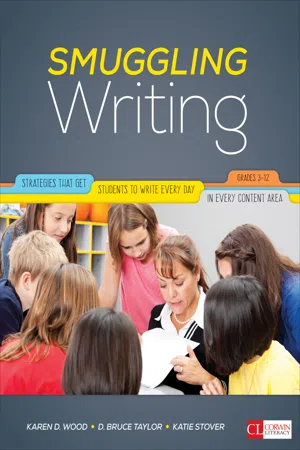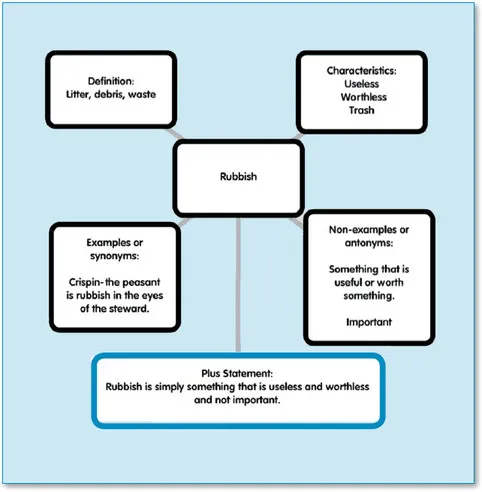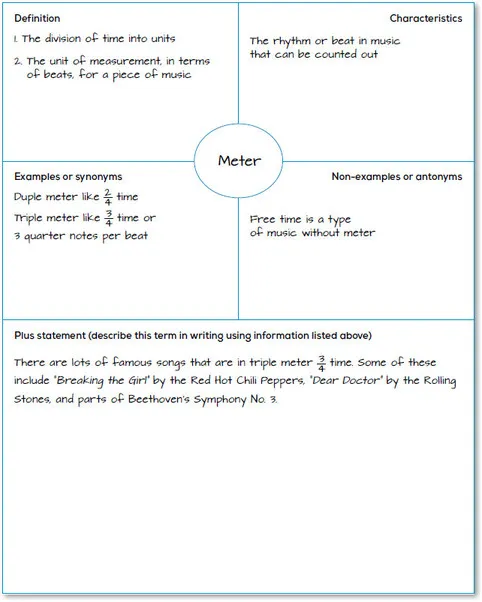
eBook - ePub
Smuggling Writing
Strategies That Get Students to Write Every Day, in Every Content Area, Grades 3-12
This is a test
- 256 pages
- English
- ePUB (mobile friendly)
- Available on iOS & Android
eBook - ePub
Smuggling Writing
Strategies That Get Students to Write Every Day, in Every Content Area, Grades 3-12
Book details
Book preview
Table of contents
Citations
About This Book
Can you sneak more writing into your already-jammed curriculum? Smuggling Writing shows how to integrate writing seamlessly into your lesson plans, with 32 written response activities that help students process information and ideas in short, powerful sessions. The authors invigorate time-tested tools and organize them into sections on Vocabulary and Concept Development, Comprehension, Discussion, and Research & Inquiry. Each strategy:
- Takes students through before, during, and after reading/learning
- Provides engaging digital applications
- Includes sample lessons
- Details connections to Common Core State Standards
Smuggling Writing shows how big gains will come from “writing small” day by day.
Frequently asked questions
At the moment all of our mobile-responsive ePub books are available to download via the app. Most of our PDFs are also available to download and we're working on making the final remaining ones downloadable now. Learn more here.
Both plans give you full access to the library and all of Perlego’s features. The only differences are the price and subscription period: With the annual plan you’ll save around 30% compared to 12 months on the monthly plan.
We are an online textbook subscription service, where you can get access to an entire online library for less than the price of a single book per month. With over 1 million books across 1000+ topics, we’ve got you covered! Learn more here.
Look out for the read-aloud symbol on your next book to see if you can listen to it. The read-aloud tool reads text aloud for you, highlighting the text as it is being read. You can pause it, speed it up and slow it down. Learn more here.
Yes, you can access Smuggling Writing by Karen D. Wood, David Bruce Taylor, Katie Stover Kelly in PDF and/or ePUB format, as well as other popular books in Education & Education General. We have over one million books available in our catalogue for you to explore.
Information
Strategy 1 Frayer Model Plus
Objective
To enable students to learn new vocabulary terms by exploring the characteristics of words including examples (synonyms) and non-examples (antonyms).
Rationale
Traditions of learning new vocabularies related to academic subjects rely primarily on learning definitions. Research shows that this definitional approach that most often involves rote memorization of words and definitions does not engage students or lead to significant learning of the academic vocabulary. The Frayer Model helps students move beyond a narrow focus on definitions to include examples (synonyms) and non-examples (antonyms). In this version—the Frayer Model Plus—we add a writing extension to provide students an opportunity to extend their interaction with new terms. See the template provided in Figure 1.1.
Digital Applications
Computer software and digital tablet applications (apps) offer great options for mapping words. Here is a list of some popular software applications that work across computer platforms:
- Inspiration: There are two versions of the Inspiration software—Inspiration and Kidspiration. Both allow students to easily create concept or bubble maps that can be adapted for use as Frayer maps. The software is available for computers (many schools and districts provide this), but it also has apps for tablet computers.
- SimpleMind+: This is an application available for the iPad that allows students to create concept maps.
- Popplet (www.popplet.com): Another iPad app that allows users to create bubble maps and concept maps. See Figure 1.2 for an example of using Popplet with the Frayer Model Plus.
Procedures
Teacher Preparation Stage
- ➔ Step One: The teacher identifies key vocabulary terms from a text, topic, or unit of study. For example, in a social studies class in which students are studying the American Civil War, the teacher might select terms including abolitionist, antebellum, blockade, cash crop, Confederacy, emancipation, Federal, Reconstruction, and secession.Optional: Selection of the vocabulary can be shared with students with some or all of the terms being self-selected by the students or the teacher and students suggesting terms.
- ➔ Step Two: The teacher decides the best method for sharing the Frayer Model Plus strategy—paper copies or a digital application such as Popplet or Inspiration. Obviously, this decision depends on availability of computers and digital tablets.
Prereading Stage
- ➔ Step Three: The teacher introduces the text, topic, or unit of study to students and discusses key vocabulary, or, if the students have identified terms, the teacher leads a brainstorming session and discussion with students to select a set of vocabulary terms.
- ➔ Step Four: The teacher displays a copy of the Frayer Model Plus and using one of the terms models its use by filling out any information about the term that students know before reading. This might include “it is related to” and “I think it means.”Optional: If using one of the digital applications such as Inspiration, Popplet, or SimpleMind+, the teacher should model how to use this.
Reading Stage
- ➔ Step Five: Students work independently to read the textbook or other text related to the unit or topic. Students should read the text and make note of key vocabulary terms as they read.Optional: Students can mark the location of key vocabulary terms using sticky notes in their text.
Postreading Stage
- ➔ Step Six: After students have had sufficient time to read, they can go back to the text and write down what they know about the key terms on the Frayer Model Plus form (paper or digital). The teacher can have students work in pairs or small groups to discuss their entries. This can be done as a whole class as well. It is important to confirm that the definitions, connections, and illustrations lead to a thorough and reasonable understanding of the terms.
- ➔ Step Seven: After students create a Frayer chart for a term, they can write out a plus statement that uses what they have learned to describe the term in their own language. The teacher can model this step and also share student examples of plus statements.
- ▪ See Figure 1.3 for an example of a completed Frayer Model Plus chart.
- ➔ Smuggling Writing: The Plus part of this strategy is the written synthesis step that allows students to summarize and synthesize the content of the selection by referring back to the text sources and using the new vocabulary and concepts in a paragraph. Since this is a practice writing exercise, students can be encouraged to work in pairs to compose a single paragraph between them.
Adaptation
Creating Frayer Collections in wikis and shared folders: As with the Personal Vocabulary Journal, it is helpful to have individual students or groups of students create collections of words or groups of Frayer Model entries. Google Drive, Dropbox, Edmodo, and wikis offer tools for teachers and students to gather, store, and retrieve multiple Frayer Model Plus entries. These can be organized by topics, units, and texts with shared access by students or can be personal collections of terms for each student.
Standards-Based Connections
Examples of Common Core Anchor Standards
- CCSS.ELA-Literacy.CCRA.R.4: Interpret words and phrases as they are used in a text, including determining technical, connotative, and figurative meanings, and analyze how specific word choices shape meaning or tone.
- CCSS.ELA-Literacy.CCRA.W.6: Use technology, including the Internet, to produce and publish writing and to interact and collaborate with others.
- CCSS.ELA-Literacy.CCRA.L.4: Determine or clarify the meaning of unknown and multiple-meaning words and phrases by using context clues, analyzing meaningful word parts, and consulting general and specialized reference materials, as appropriate.
- CCSS.ELA-Literacy.CCRA.L.5: Demonstrate understanding of figurative language, word relationships, and nuances in word meanings.
- CCSS.ELA-Literacy.CCRA.L.6: Acquire and use accurately a range of general academic and domain-specific words and phrases sufficient for reading, writing, speaking, and listening at the college and career readiness level; demonstrate independence in gathering vocabulary knowledge when encountering an unknown term important to comprehension or expression.
References
, , & (1969). A schema for testing the level of cognitive mastery. Madison: Wisconsin Center for Education Research.

Figure 1.1 Frayer Model Plus
Copyright © 2016 by Corwin. All rights reserved. Reprinted from Smuggling Writing: Strategies That Get Students to Write Every Day, in Every Content Area, Grades 3–12 by Karen D. Wood, D. Bruce Taylor, and Katie Stover. Thousand Oaks, CA: Corwin, www.corwin.com. Reproduction authorized only for the local school site or nonprofit organization that has purchased this book.

Figure 1.2 Using Frayer Model With Popplet for the Term “Rubbish”
Source: Content created by Rachael Rovenstine and Tiffany Fulton. Screenshots from Popplet.

Figure 1.3 Using Frayer Model Plus With the Musical Term “Meter”
Strategy 2 Semantic...
Table of contents
- Cover
- Acknowledgements
- Half Title
- Acknowledgements
- Title Page
- Copyright Page
- Contents
- Preface
- Acknowledgments
- About the Authors
- A Matrix for Using This Book
- Publisher Note
- Section I Vocabulary and Concept Development
- Strategy 1 Frayer Model Plus
- Strategy 2 Semantic Feature Analysis Plus
- Strategy 3 Vocabulary Cards
- Strategy 4 Vocabulary-Concept Journals
- Strategy 5 Vocabulary Self-Awareness Chart
- Section II Comprehension
- Strategy 6 List–Group–Label–Write
- Strategy 7 Book Reviews/Book Trailers
- Strategy 8 Generating Interactions Between Schemata and Text (GIST)
- Strategy 9 Extended Anticipation Guide
- Strategy 10 Possible Sentences
- Strategy 11 Story Impressions
- Strategy 12 Reading Road Map
- Strategy 13 Say Something and Summarize
- Strategy 14 Somebody–Wanted–But–So–Then
- Strategy 15 Exchange Compare Writing
- Strategy 16 RAFT Writing
- Strategy 17 So What?
- Strategy 18 Found Poetry Summaries
- Strategy 19 Sticky Note Maps
- Strategy 20 Double Entry Journal/Dialectic Response Journal
- Section III Research and Inquiry
- Strategy 21 1–2–3 Research
- Strategy 22 Collaborative Listening Viewing Guide (CLVG)
- Strategy 23 Herringbone
- Strategy 24 Inquiry Charts
- Strategy 25 KWL Plus
- Strategy 26 Multiple Source Research Strategy
- Strategy 27 Web Page Evaluation Tools
- Section IV Discussion
- Strategy 28 Discussion Webs
- Strategy 29 Talking Drawings
- Strategy 30 Tea Party
- Strategy 31 Think–Pair–Share–write
- Strategy 32 Ticket to Talk
- Publisher Note